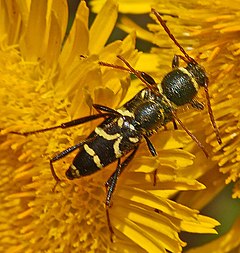
Clytus is a genus of longhorn beetles in the family Cerambycidae.

Lamiinae, commonly called flat-faced longhorns, are a subfamily of the longhorn beetle family (Cerambycidae). The subfamily includes over 750 genera, rivaled in diversity within the family only by the subfamily Cerambycinae.

Cerambycinae is a subfamily of the longhorn beetle family (Cerambycidae). The subfamily has a world-wide distribution including: Asia, Europe and the Americas. Within the family, the only subfamily of comparable diversity is the Lamiinae.
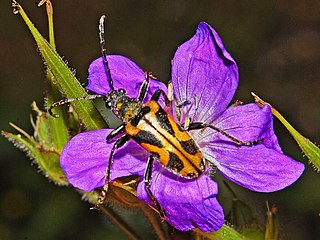
Brachyta interrogationis is the species of the Lepturinae subfamily in long-horned beetle family. This species was described in 1758 by Carl Linnaeus in the 10th edition of Systema Naturae under the name Leptura interrogationis.

Gaurotes virginea is a species of the Lepturinae subfamily in the long-horned beetle family.

Chlorophorus sartor is a species of beetle of the family Cerambycidae, subfamily Cerambycinae.

Pseudovadonia livida, the fairy-ring longhorn beetle, is a beetle species of flower longhorns belonging to the family Cerambycidae, subfamily Lepturinae.

Rutpela maculata, the spotted longhorn, is a beetle species of flower longhorns of the family Cerambycidae, subfamily Lepturinae.

Cerambycini is a tribe of longhorn beetles classified under the subfamily Cerambycinae.

Stenurella bifasciata is a species of beetle in the family Cerambycidae.

Mallosia, described by Étienne Mulsant in 1847, is a genus of longhorn beetles of the subfamily Lamiinae, tribe Saperdini. It is distributed in the Palearctic, from Greece to Caucasus and Iran.
Agapanthia kindermanni is a species of beetle in the family Cerambycidae. It was described by Pic in 1905. It is found in Turkey, including Hatay Province, İçel Province, Adana Province and Osmaniye Province.
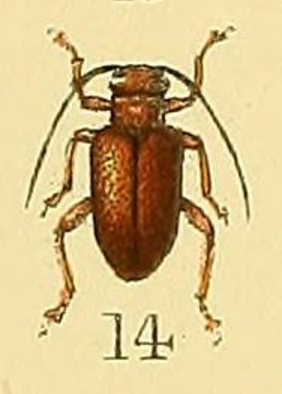
Entelopes is a genus of longhorn beetles of the subfamily Lamiinae, containing the following species:
Mallosia nonnigra is a species of beetle in the family Cerambycidae. It was described by Hüseyin Özdikmen and Fatih Aytar in 2012. It is known from Turkey.

Nathrius brevipennis is a species of beetle in family Cerambycidae. It is found in the Palearctic but has been spreading by commerce and is now cosmopolitan. It is 4–7 mm. long. It is polyphagous on dead twigs of dominantly broadleaved trees

Alosterna tabacicolor is a species of beetle in family Cerambycidae.

Grammoptera ruficornis is a species of beetle in family Cerambycidae.

Chlorophorus figuratus is a species of round-necked longhorns belonging to the family Cerambycidae, subfamily Cerambycinae.
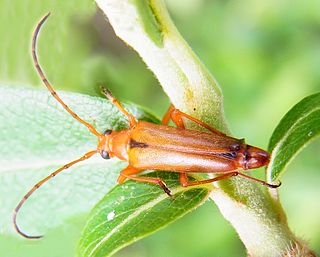
Pedostrangalia is a genus of beetles which belong to the subfamily Lepturinae in the family of longhorn beetles.
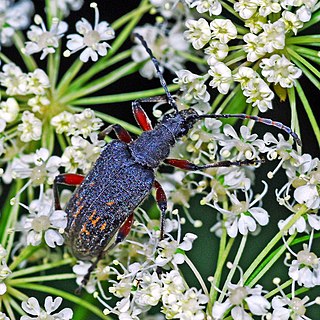
Evodinus clathratus is a species of beetles in the family Cerambycidae.

